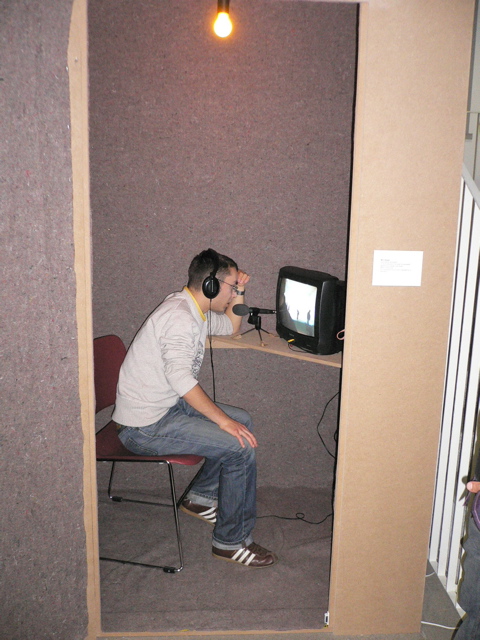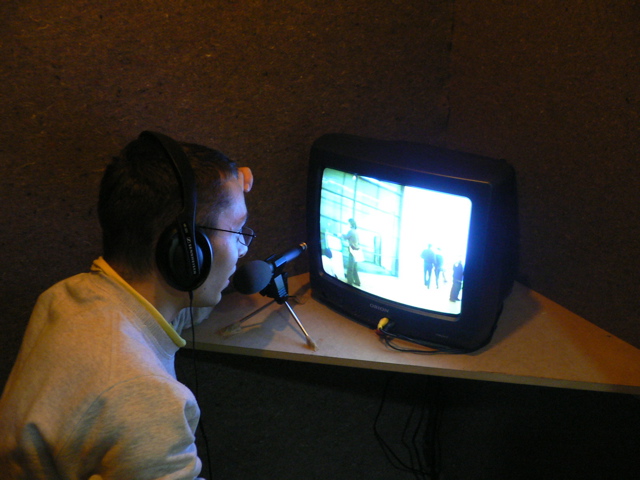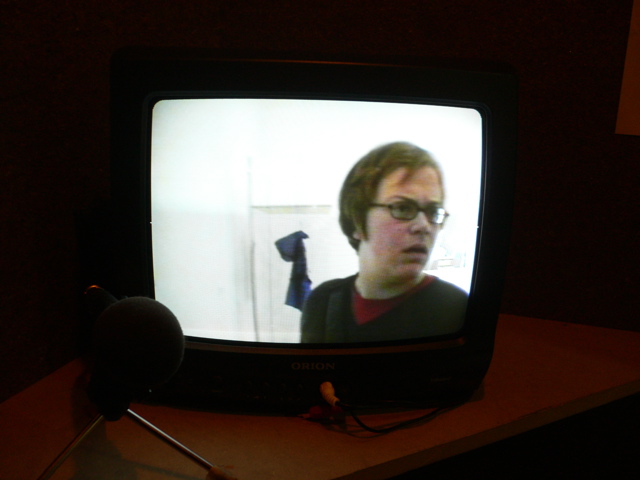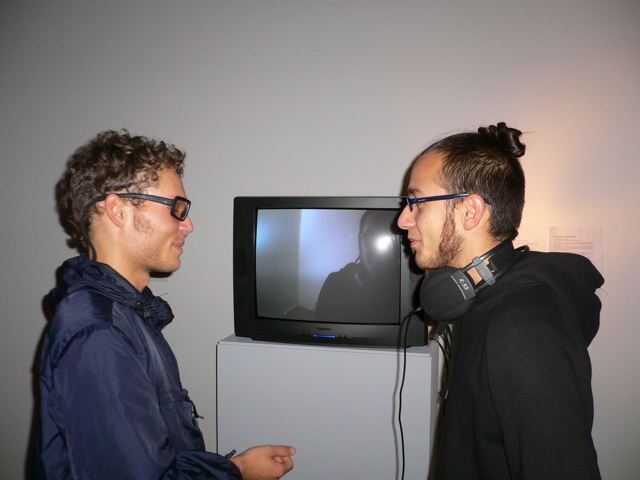Co-Operation
A PARTICIPATORY MIXED PERFORMANCE (2006) — made specifically for the exhibition Liminal Spaces at the Gallery for Contemporary Arts Leipzig, GermanyתTechnology: Spy Camera, Covert Microphone, Earset, Control Booth







Co-Operation was created for “Liminal Spaces” exhibition at
the Gallery for Contemporary Arts Leipzig
curated by Galit Eilat,
Eyal Danon, Reem Fadda and Philipp Misselwitz
"Co-Operation" attempts to address the mind-body problem as well as the politics of role-playing by service agents in contemporary society.
This work was created for the exhibition ‘Liminal Spaces’; an exhibition and a conference that took place in 2006 as a result of an eight-month international art project which aims at refuting the realities of the Israeli occupation of Palestine and its dynamics by examining notions of urban spaces, borders, mental and physical segregation, cultural territories, and the possibilities of art within a political framework. There were several dozens of artists participating in this exhibition from Israel, Palestine, and other nationalities. The idea behind this work was to create a mechanism for engaging politically with other viewers without the responsibilities of doing it from your own body - with the hope that it would allow difficult topics to be addressed.
A human actor personifying an avatar moves around a public exhibition space offering himself to the control of a viewer who sits in a remote and secluded cabin. A small cabin or booth is located at one point in the exhibition space. The entrance to the cabin is hidden from the public, and a single spectator can slip inside and close the door behind him. A sign on the cabin will then light up to signify that the cabin is occupied.
Upon entering the booth, which contains a monitor, a headset, and a microphone, the spectator finds him/herself “inside” the actor's body: the image projected on the monitor shows what the actor is seeing at any given moment, while the headset transmits the sounds which the actor is hearing. The spectator can give orders to his new “body” via the microphone. The actor is wearing special glasses, hidden in them is a miniature spy video camera and a microphone. They transmit his experience in real-time to the cabin. A hidden earphone enables the actor to receive the command of the person in the cabin. The spectator in the cabin, now the operator of the actor, can command the actor where to go, what to say, and what to see in real-time. A mirror is situated in the exhibition space, and as the operator becomes acquainted with his new body, he/she can ask the actor to face the mirror and communicate to him his/her particular desires regarding his/her bodily and facial gestures. If the actors don't understand the operator's command, then he is instructed to look down to his toes, indicating to the operator that he should restate or change his command. The mirror is also the designated area for the operator to develop specific codes of communication with his new body, for instance, nodding for YES, looking at his nails for NO, etc. Other viewers entering the space at that moment would see a person behaving strangely in front of the mirror. In theory, the spectator in the cabin can activate the actor and communicate via the actor with other spectators in the exhibition space. Their conversation is not predetermined. It may be about politics, the contents of the exhibition or even a flirtation may arise…In practice, all sorts of misunderstandings spring up between the operator and his new body- the actor. The attempt to establish communication between them becomes a central issue the work addresses.
This work was created for the exhibition ‘Liminal Spaces’; an exhibition and a conference that took place in 2006 as a result of an eight-month international art project which aims at refuting the realities of the Israeli occupation of Palestine and its dynamics by examining notions of urban spaces, borders, mental and physical segregation, cultural territories, and the possibilities of art within a political framework. There were several dozens of artists participating in this exhibition from Israel, Palestine, and other nationalities. The idea behind this work was to create a mechanism for engaging politically with other viewers without the responsibilities of doing it from your own body - with the hope that it would allow difficult topics to be addressed.
A human actor personifying an avatar moves around a public exhibition space offering himself to the control of a viewer who sits in a remote and secluded cabin. A small cabin or booth is located at one point in the exhibition space. The entrance to the cabin is hidden from the public, and a single spectator can slip inside and close the door behind him. A sign on the cabin will then light up to signify that the cabin is occupied.
Upon entering the booth, which contains a monitor, a headset, and a microphone, the spectator finds him/herself “inside” the actor's body: the image projected on the monitor shows what the actor is seeing at any given moment, while the headset transmits the sounds which the actor is hearing. The spectator can give orders to his new “body” via the microphone. The actor is wearing special glasses, hidden in them is a miniature spy video camera and a microphone. They transmit his experience in real-time to the cabin. A hidden earphone enables the actor to receive the command of the person in the cabin. The spectator in the cabin, now the operator of the actor, can command the actor where to go, what to say, and what to see in real-time. A mirror is situated in the exhibition space, and as the operator becomes acquainted with his new body, he/she can ask the actor to face the mirror and communicate to him his/her particular desires regarding his/her bodily and facial gestures. If the actors don't understand the operator's command, then he is instructed to look down to his toes, indicating to the operator that he should restate or change his command. The mirror is also the designated area for the operator to develop specific codes of communication with his new body, for instance, nodding for YES, looking at his nails for NO, etc. Other viewers entering the space at that moment would see a person behaving strangely in front of the mirror. In theory, the spectator in the cabin can activate the actor and communicate via the actor with other spectators in the exhibition space. Their conversation is not predetermined. It may be about politics, the contents of the exhibition or even a flirtation may arise…In practice, all sorts of misunderstandings spring up between the operator and his new body- the actor. The attempt to establish communication between them becomes a central issue the work addresses.